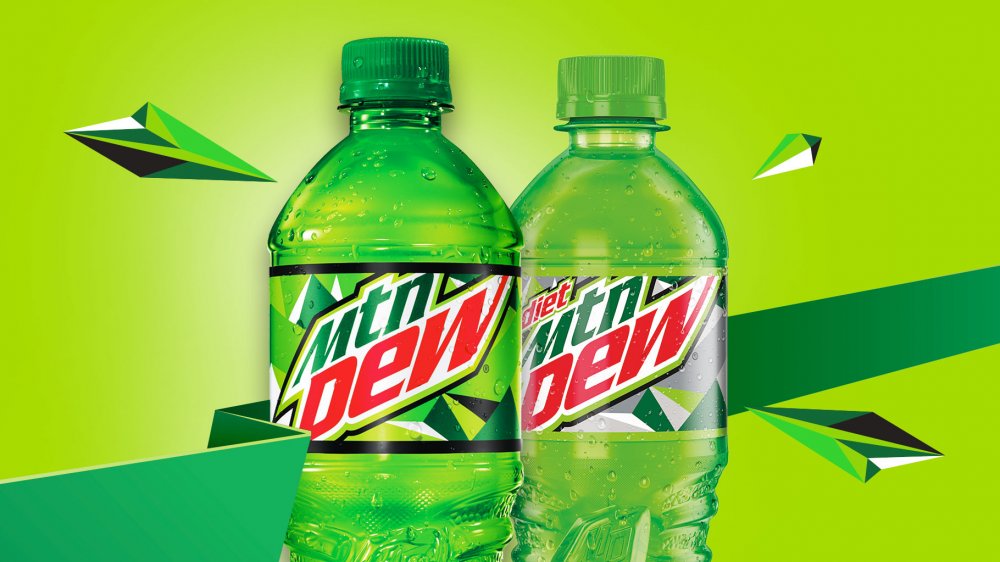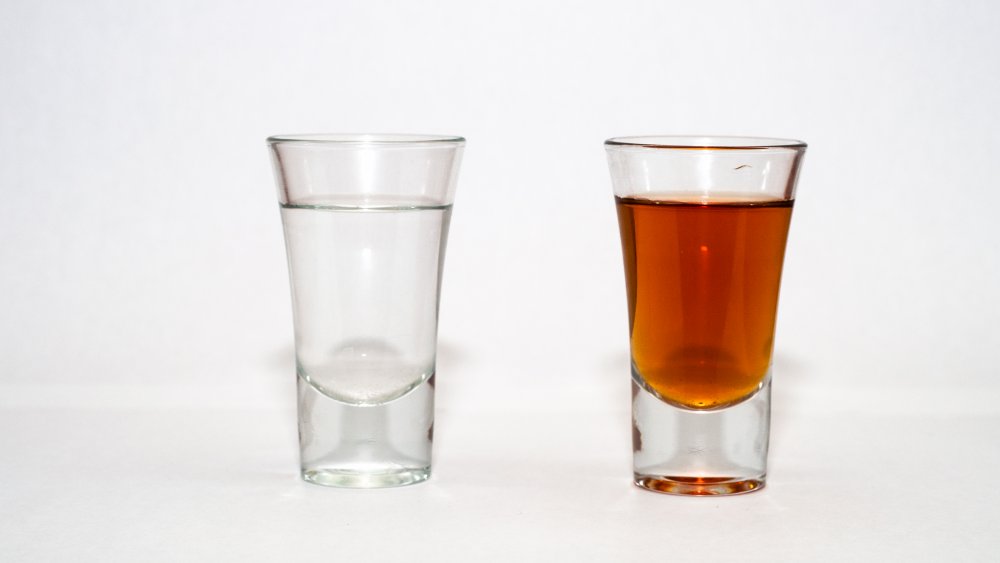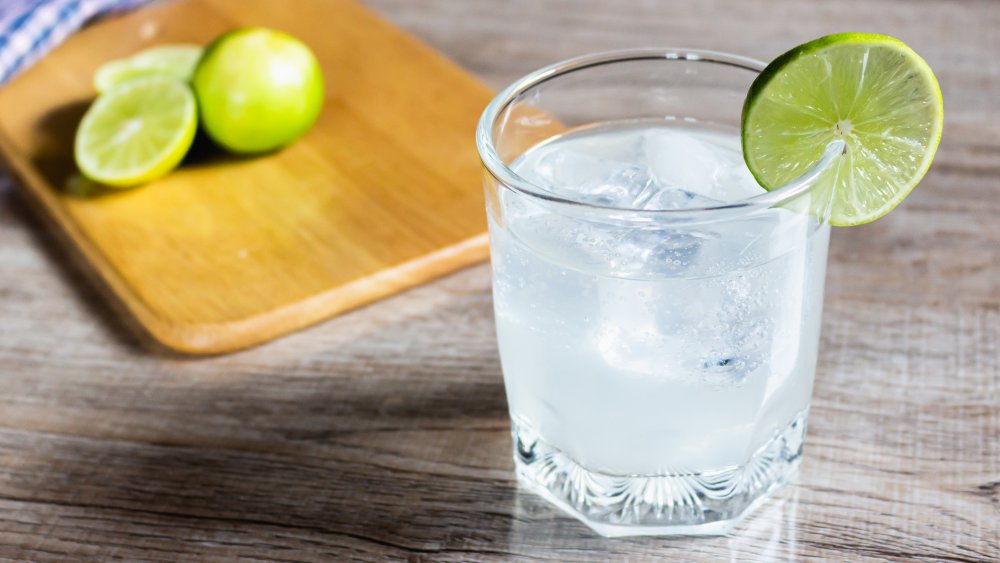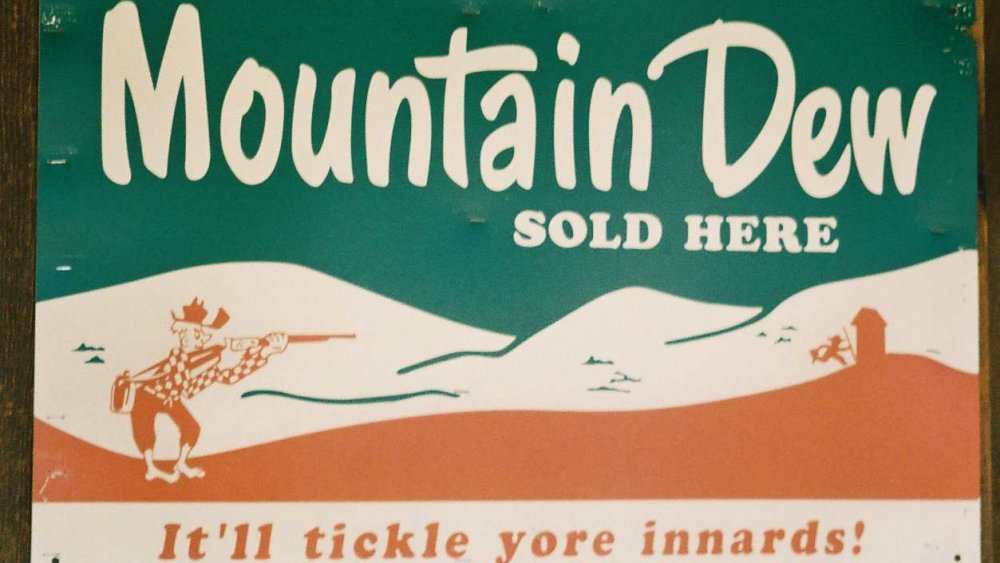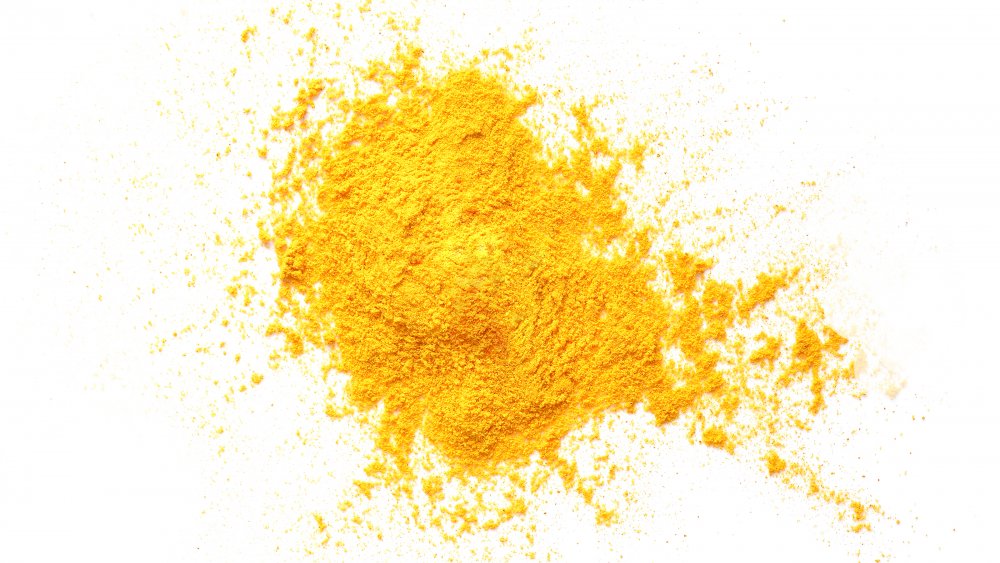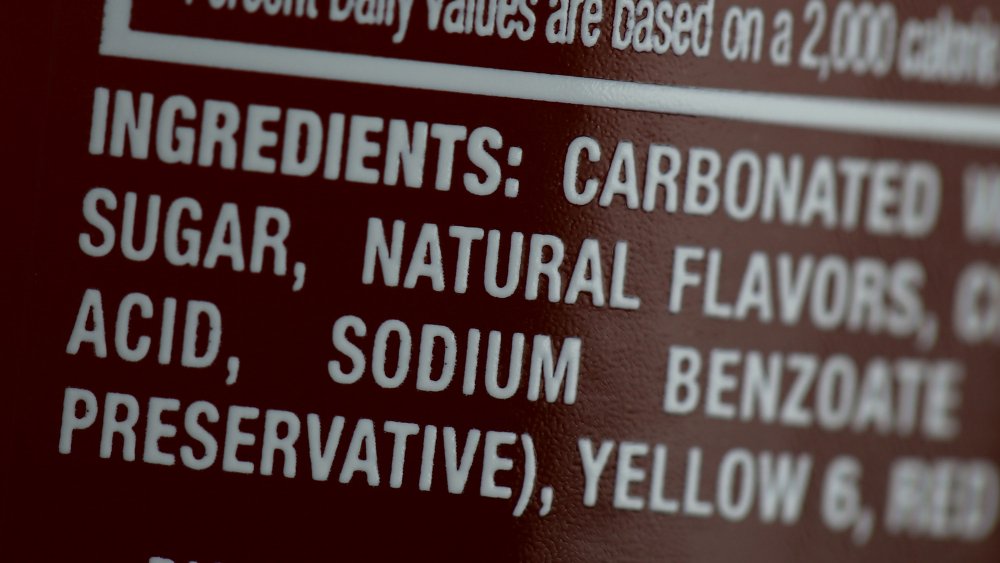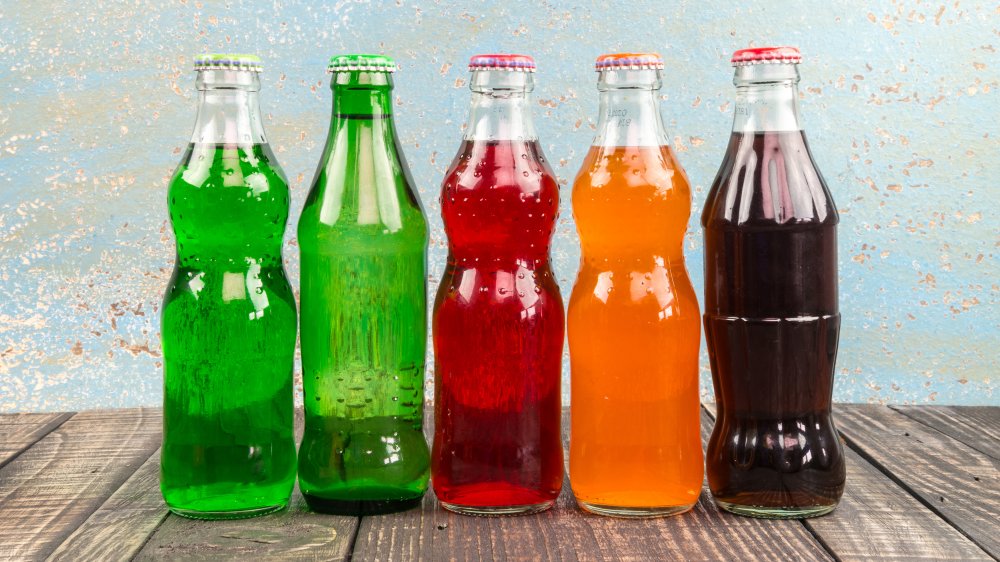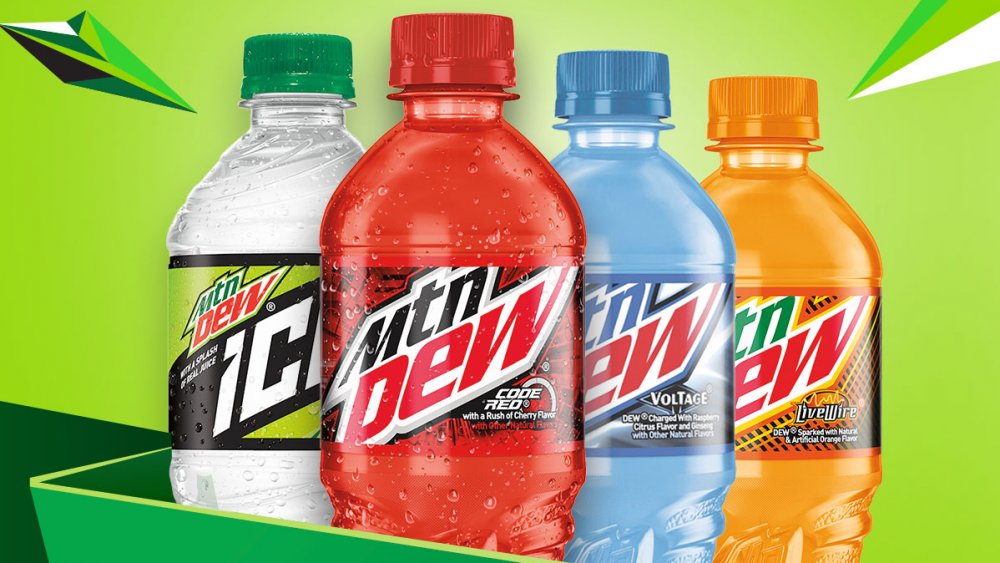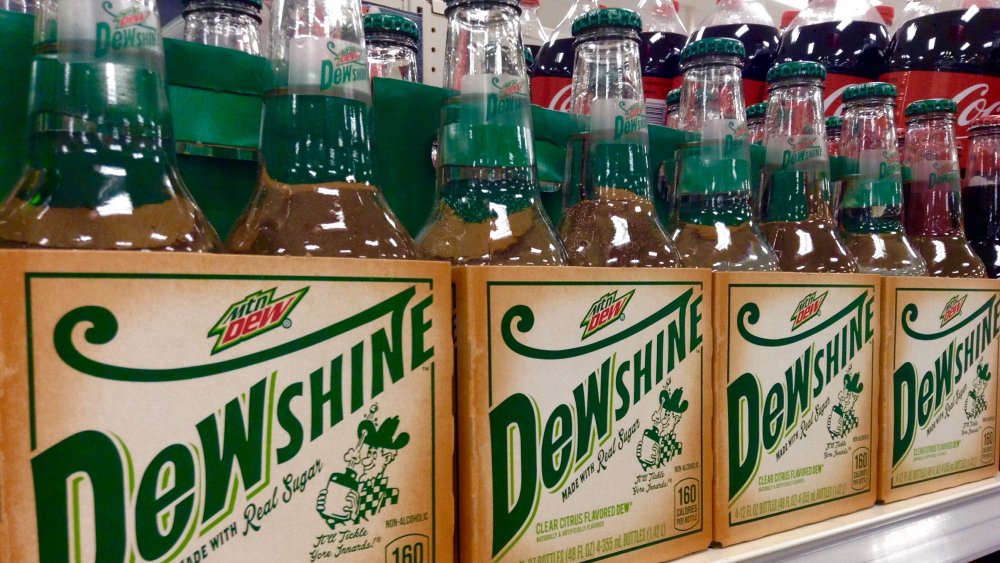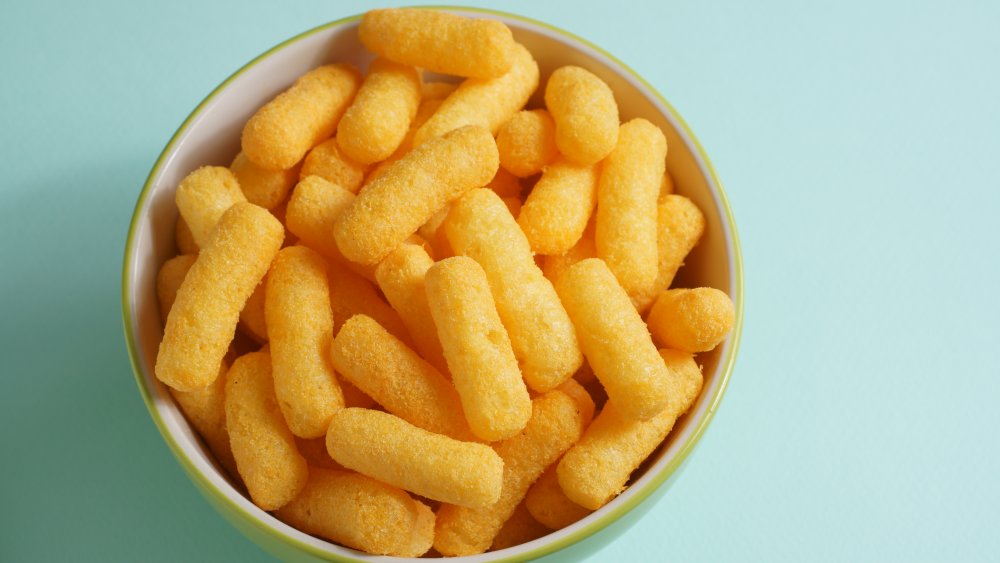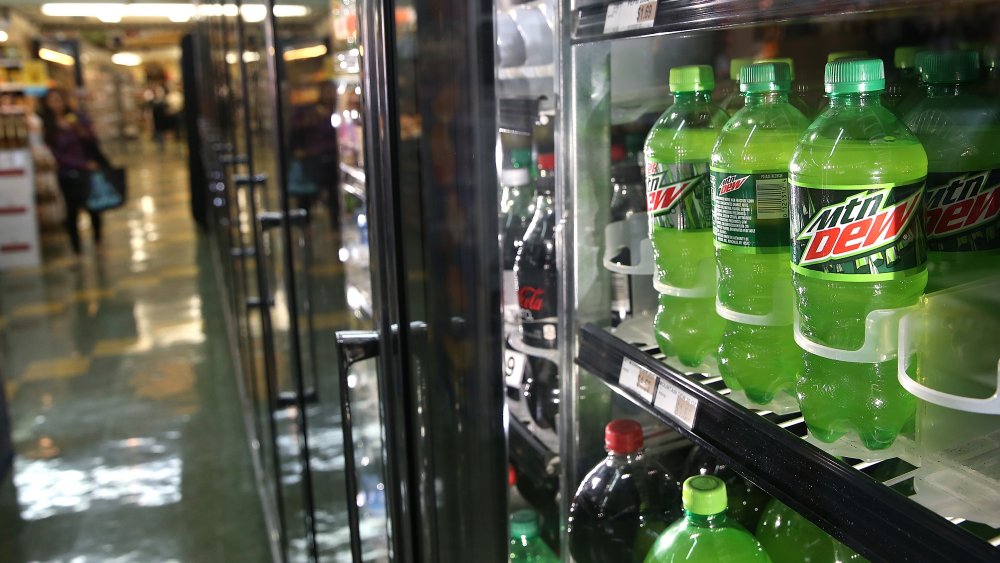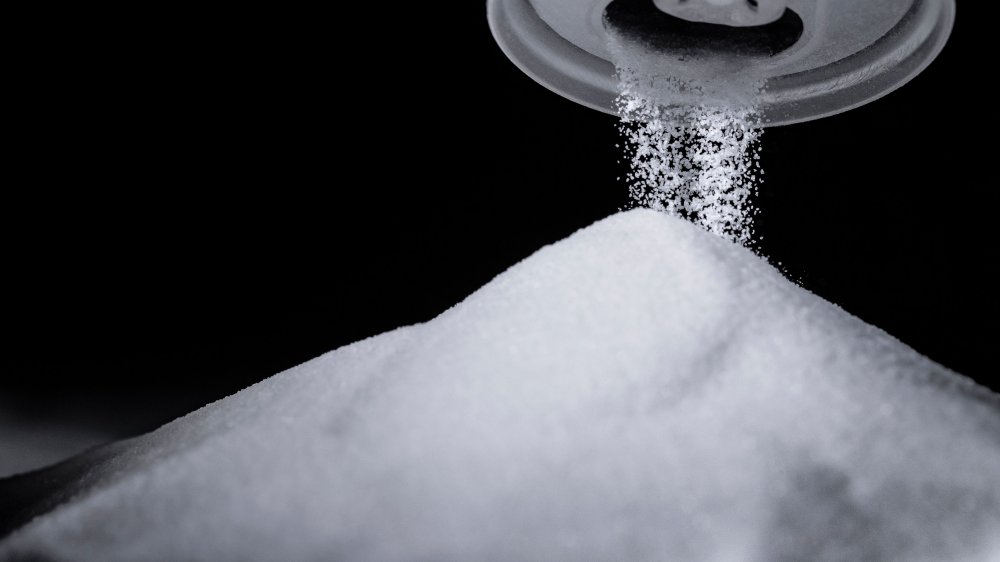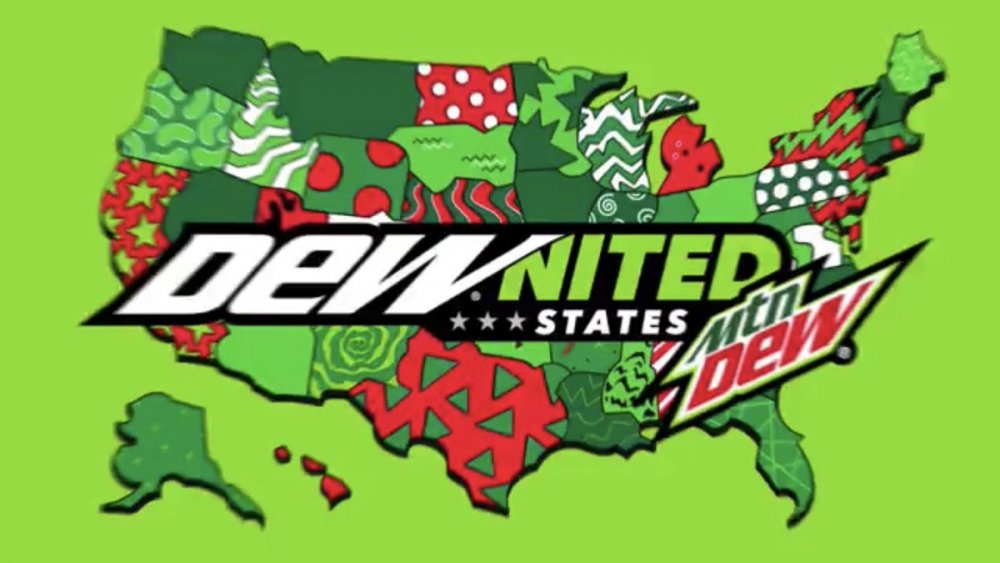The Untold Truth Of Mountain Dew
Mountain Dew is everywhere these days. This highly-caffeinated, electric-colored drink is marketed toward a young crowd looking to live life on the edge. It's not uncommon to see extreme sports like skateboarding or mountain biking in their ads, or people attending crowded concerts or participating in all-nighter video game binges. Their marketing campaign seems to work, too; as of 2018, Mountain Dew is the fourth most popular soda, with a six to seven percent overall market share. But, it wasn't always that way. According to Appalachian Magazine, Mountain Dew had a rocky start.
The original creators, Barney and Ally Hartman, struggled to get Dew to take off, and they even tried to sell it to Coca-Cola in the early days. They eventually found a buyer in Virginia's Tip Corporation, who modified the drink to make it taste more citrus-forward. The changes worked, and the highly flavorful, super caffeinated beverage became such a big hit that Pepsi bought it in 1964. The rest is history; Pepsi's national distribution put Mountain Dew in people's hands all around the country and paved the way for Mountain Dew to develop several additional flavors.
You might think you know everything there is to know about this neon drink, but its rocky history isn't the only interesting tidbit about Mountain Dew.
Mountain Dew was originally developed as a mixer for whiskey
Mountain Dew soda was born in the foothills of the Smoky Mountains in Knoxville, Tennessee. Long before it became a soda, the term "mountain dew" was a nickname for moonshine. In the 1930s or '40s (sources vary on the year), brothers Barney and Ally Hartman created a mixer to make whiskey taste better. Knoxville historian and author, Jack Neely, told WBIR that the brothers "originally only made it for themselves," and their version didn't have caffeine. In Fizz: How Soda Shook Up the World, author Tristan Donovan goes on to explain that the brothers' favorite bourbon mixer, a lemon-lime drink called Natural Set-Up, wasn't available when they moved to Tennessee, so they decided to make their own.
The brothers jokingly named the beverage Mountain Dew after the term's nickname, joking that it tasted just like moonshine when mixed with liquor. They put a Tennessee moonshiner on the logo and marketed the drink as a "zero-proof hillbilly moonshine that will tickle yer innards." The pair expanded distribution outside Knoxville but sales stalled, and the company began to struggle after Barney Hartman tragically died of a heart attack.
The original version of Mountain Dew didn't taste anything like it does today
The idea of mixing brown liquor with vibrant green soda doesn't exactly sound appealing, but luckily that wasn't what the Hartman brothers were doing. According to WBIR, the original Mountain Dew was a caffeine-free, clear colored, lemon-lime flavored beverage — similar to 7UP or Sprite. The Hartman brothers sold Mountain Dew to the Tip Corporation of Marion, Virginia, but the drink needed a makeover to boost sales.
Here's where history gets a little murky. Some say that Bill Jones of the Tip Corporation started tweaking the formula, adding a little tang to the drink. He reportedly brought cups filled with different formulas to local drug stores and asked Marion residents to tell him which was their favorite. Others say that Johnson City, Tennessee, is the true home of Mountain Dew because Tri-City Beverages plant manager, Bill Bridgeforth, started adding his Tri-City Lemonade to Mountain Dew bottles, and the more citrus-forward version took off. No matter which version is true, one thing is indisputable: Mountain Dew became the electric-colored, highly caffeinated beverage, and people loved it.
Mountain Dew's logo originally featured rifle-toting hillbillies
Today's Mountain Dew deftly targets their advertising towards young males living exciting lifestyles, but that type of marketing happened long after Pepsi bought the brand in 1964. According to Tristan Donovan's book Fizz: How Soda Shook Up the World, the original Mountain Dew bottles were decorated with a shoeless hillbilly who carried a rifle and a jug of moonshine. The image was later expanded to show the hillbilly shooting at a government revenuer from an outhouse, a throwback to Prohibition times when Mountain Dew was a nickname for moonshine.
Pepsi kept the hillbilly image when they bought the soda, hoping to capitalize on the popularity of the hillbilly lifestyle from The Beverly Hillbillies TV show. In the first Mountain Dew commercial in 1966, Pepsi featured the hillbillies shouting, "Ya-hooo, Mountain Dew" and went with a tagline of "It'll tickle yore [sic] innards!" As time went on, Pepsi started marketing to a younger crowd, adopting the "Do the Dew" tagline and dropping the hillbillies bit in exchange for images and spokespeople that appealed to a more high-octane, thrill-seeking crowd. They eventually even dropped the unnecessary letters from their label, shortening their name on cans and bottles to Mtn Dew.
Mountain Dew gets its color from Yellow 5, a controversial ingredient
Is Mountain Dew yellow, green, or a color that the English language can't yet describe? Their marketing team insists it's the latter. In an interview with BuzzFeed News, Mountain Dew's vice president of marketing, Greg Lyons, admits that they never describe the color in their advertising. He'd prefer if we called it "Mountain Dew color." When the interviewer forced the issue and asked for a real adjective, he called the iridescent soda "neon... that's if you're forcing me to describe it."
The ingredient that gives Mountain Dew its electric color? The synthetic food dye tartrazine, better known as Yellow 5. This dye is FDA approved to give foods a boost of yellow color, and it's used in somewhat high quantities in a soda as vibrant as Dew. Although no one knows where the rumor began, Snopes discredited the urban myth that the dye will shrink testicles, make a penis smaller, or lower sperm counts. That doesn't make it any less of a controversial ingredient, though. Companies in the US are required to list Yellow 5 on an ingredients list as some people have a sensitivity to it, and the ingredient is banned in Norway and Austria.
Mountain Dew contains some weird ingredients
Yellow 5 isn't the only surprise ingredient in Mountain Dew. There are several familiar ingredients on the Mountain Dew label: carbonated water, high-fructose corn syrup (the soda industry's sweetener of choice), citric acid (a sour flavoring ingredient that gives the drink its lemon-lime flavor), and caffeine. Many of the remaining ingredients are used as a preservative, but two of the ingredients stand out: orange juice and Brominated Vegetable Oil (BVO).
Part of what gives Mountain Dew its tangy flavor is the addition of concentrated orange juice. According to MEL Magazine, concentrated OJ has been filtered to remove all the water, resulting in a juice that's seven times more concentrated than the original. They don't use enough to provide any meaningful vitamin C to your diet, but it's enough to add a wallop of flavor.
The other interesting ingredient is BVO. BVO's purpose is to act as an emulsifier, helping to distribute the flavor evenly throughout the drink. It's a controversial ingredient because it's also a patented flame retardant for plastics, and it's been banned in Europe and Japan. It's generally considered safe to consume, though — you'll find it in about 10 percent of sodas and in many sports drinks.
Mountain Dew has more caffeine that most soda
When Mountain Dew was re-tooled from being a whiskey mixer to a stand-alone soda, one of the things they added was caffeine. According to the Center for Science in the Public Interest, a 12-ounce bottle of Mountain Dew contains 54 milligrams (mg) of caffeine. That might not seem like that much when compared to a 12-ounce Starbucks coffee's 235 mg (ahem, sorry, we meant to say Tall coffee). But, when compared to Coca-Cola Classic's 34 mg and Pepsi's 38 mg, it's a big jump.
Caffeine used to be a natural part of soda, back when cola drinks actually extracted their flavor from the kola nut. That's not the case today, so drink manufacturers add caffeine as an added ingredient. In the 1980s, the U.S. Food and Drug Administration (FDA) tried to eliminate added caffeine from soft drinks. Manufacturers argued that caffeine was used as a "flavor enhancer," and the agency agreed to continue allowing it. All that added caffeine in Mountain Dew doesn't only keep you alert, either; studies have found that high doses of caffeine can lead to a decrease in fat mass and body weight. Unfortunately, all that sugar probably counteracts that benefit.
There have been a lot of Mountain Dew flavors over the years
Mountain Dew's electric color has opened up doors for the soft drink company. They've released spin-off flavors in just about every color of the rainbow. There's the exclusive Taco Bell flavor, Mountain Dew Baja Blast, with its epic aquamarine color and lime-forward flavor. In 2019, KFC announced their first exclusive Mountain Dew flavor, Sweet Lightning, a peach- and honey-flavored soda that was specifically created to pair well with the chain's signature fried chicken.
In addition to their exclusive restaurant deals, Mountain Dew has an incredible collection of flavors available at the grocery store. We'd love to over-caffeinate ourselves one day by trying every single flavor of Mountain Dew, but there are so many to try and we do like to sleep from time to time. Luckily, a writer at Vice did it for us. Some of the top flavors include the vibrant orange Live Wire, dark berry Black Label, and Code Red — a copycat of the first Mountain Dew spin-off that came out in 1988. Other flavors that rank highly include the Voltage and Live Wire. Mountain Dew isn't satisfied with their suite of flavors, because they're always testing out new flavors (like the Doritos-flavored Mountain Dew aptly named Dewritos that was tested at universities in 2014). You never know what they'll come up with next!
Mountain Dew had a throwback version in 2015 called DEWshine
Mountain Dew has rolled out several throwback versions, including a Mountain Dew Throwback made with real sugar released in 2009. Their 2015 version — called DEWshine — didn't fare as well. The clear soda looked very similar to the original lemon-lime version, and it was made with real sugar (like the original). What made it unpopular was the criticism that it blurred the lines between alcoholic and nonalcoholic beverages. Unlike most American soda, DEWshine was released in clear glass bottles, which USA Today commented looked very similar to craft beer. The bottles were clearly labeled as "non-alcoholic," but the TV commercials marketed the product as "available legally for the first time"
The look wasn't the only controversy surrounding this release. Dewshine is also a nickname for Mountain Dew mixed with racing fuel, a mixture that has proven deadly. The Centers for Disease Control (CDC) warned that racing fuel is almost entirely composed of methanol, and consuming just one tablespoon is deadly. It's not surprising that Mountain Dew eventually discontinued DEWshine.
Mountain Dew inspired a limited-edition Cheetos flavor in Japan
Limited edition food items can be great, but they can also be disastrous. Buffalo Wild Wing's 2015 Mountain Dew wings are definitely a great example of a Mountain Dew flavor that just didn't work out. A reviewer at the Huffington Post described it as throat-burning with "a weird artificial lime-y flavor." No, thank you! Japan's Mountain Dew-flavored Cheetos was similarly weird, but they had more of a cult following. They weren't available for long, but they were well sought after, despite mixed reviews. According to Redditors, the chips tasted like "sweet lemon lime chips" — weird, but not necessarily gross.
It's not Mountain Dew's first collaboration with Frito-Lay (another PepsiCo-owned company). In 2008, Doritos released their mystery flavored Doritos Quest, which was later revealed as Mountain Dew. Tasters at The Takeout described the chips as being "indistinctly citrus with an odd tang." Like the Cheetos, they weren't necessarily disgusting, but they did have an odd sweetness for a savory chip.
It's not possible to find a mouse in your Mountain Dew
In what has to be one of the most bizarre legal defenses around, Pepsi defended a lawsuit by proving that Mountain Dew is acidic enough to dissolve a mouse. In 2008, Ronald Ball bought a can of Mountain Dew that he claimed contained a dead mouse, causing him to become violently ill after the first sip. He filed suit against PepsiCo (Mountain Dew's parent company), seeking $75,000 in damages.
In their defense, Pepsi submitted an affidavit by veterinarian Lawrence McGill, who testified that a mouse submerged in an acidic fluid (such as Mountain Dew) would "have no calcium in its bones" after four to seven days. By 30 days of exposure, a mouse would completely disintegrate, to the point that it would actually transform into "a 'jelly-like' substance." Since Ball opened the can 74 days after it was packaged, Pepsi claims it would be impossible to find an intact mouse inside the can. Other experts, however, disputed that claim.
Can we say gross? The Madison Record reported that, while Pepsi continued to deny liability, the lawsuit was settled out of court for an undisclosed amount.
Mountain Dew contains a ridiculous amount of sugar
If you're a big Mountain Dew fan, you might not want to read this part. Like most soft drinks, Mountain Dew is loaded with sugar. Spoon University measured out a 20-ounce bottle's 77 grams of sugar, and it's the equivalent of what you would find in over eight sugar cookies. Most of us can down a bottle of soda in a few minutes flat, but can you imagine eating that many cookies in one sitting? Let's think about it another way: Harvard School of Public Health estimates that every teaspoon of sugar weighs about 4.2 grams. So our 77 grams is 18 teaspoons. Yikes!
Mountain Dew isn't alone in the sugar department, either. Many Minute Maid juices clock in above 70 grams of sugar, as does Mug Root Beer and all the flavors of Fanta. We're not saying it's all bad — there are a lot of false facts about sugar that you might think are true — but it does make you think twice about grabbing a second soda in one sitting.
Mountain Dew issued an apology to Michigan's Upper Peninsula
Mountain Dew has released some pretty killer ads in the past — including the Puppymonkeybaby ad that generated 2.2 million online views and over 300,000 social interactions during the 2016 Superbowl (according to Cleveland.com). Unfortunately, a 2019 "Dewnited States," marketing campaign resulted in some pretty embarrassing results. The intent was to feature a unique bottle design for each of the 50 states along with their newest flavor, a blend of 50 different flavors combined in one called Liberty Brew.
When they released their map of the United States, they shaded each state with a different color or pattern. Instead of including the Upper Peninsula with Michigan, they mistakenly shaded it the same color as Wisconsin. The peninsula's official twitter account struck back, calling out Mountain Dew: "I 👏 AM 👏 NOT 👏 WISCONSIN 👏 Fix this, or send a free case to all my residents. Your call. Sincerely, America's Peninsula."
Mountain Dew promptly tweeted back an apology, reminding themselves at the end with a note to self that the Upper Peninsula is "located in MICHIGAN." In their defense, it's not the first time someone forgot about the Upper Peninsula. The peninsula may cover 1/3 of the state, but it's missing from maps so often that the Michigan House of Representatives had to pass a bill requiring all state documents to depict both the upper and lower peninsula of the state.
